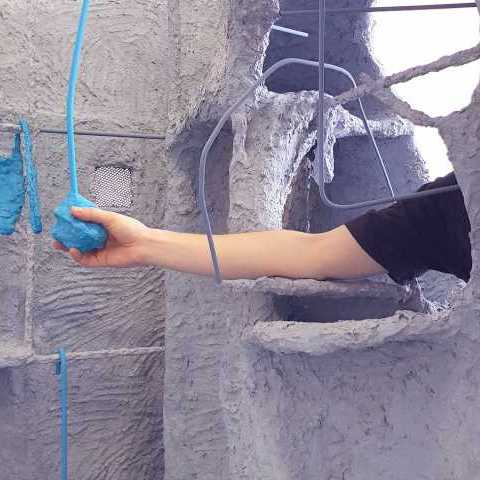
Opening Tuesday 25th September, 6:30 - 8:30 pm
26th September - 4th November 2018 (by appointment only)
For her exhibition at Lily Brooke gallery, Olivia Bax has created a sculpture that has both an affinity with the concise domestic space in which it is shown and is completely alien from it. Roost fills the gallery with purpose, demanding that we get in close and measure it against what we know (or think we know). There is little room to stand back and contemplate. Memories of domestic spaces fade in and out of focus as we test ourselves against what Bax has created, and we stand bewildered while our muscle memory encourages our bodies towards an understanding our heads cannot process. There is a strong and impish sense of humour at play – something somewhere is watching - Is it perhaps Roost’s partner in crime Eyrie, hanging from the ceiling enjoying the show?
Through a rigorous studio process Bax has poured her immediate physicality into these sculptures, and while we see and understand this on an empathetic and intellectual level, the finished works are nothing less than themselves. The ego is fully present, but it belongs to the sculpture, not the sculptor. Bax’s understanding of materials and her physical empathy with them mean that those materials are utterly subservient to her wishes. She can manipulate steel, plaster, chicken wire and papier-mâché so that they become an immediate tangible manifestation of her thoughts. Here, with Roost, we see an armature emerging and disappearing again, drawing itself a frame-like line. There, a pleasingly simple and ergonomically efficient hanging vessel, its vivid colour and texture highlighting the dragged finger marks on its surface. Typically this level of physical immediacy can be evinced only by small scale bronze or clay work where the object bears the mark of the sculptor’s hand, but Bax has expanded this immediacy to a bodily scale; the marks, gouges, mouldings and hollows act as an echo of her movements. This is not a cold, hard edged industrial structure; it is a manifestation of physicality that is almost organic, flesh-like. We sense that there has been a body here – the sculptor’s body – but she is long gone. It slowly dawns on us that we have stumbled into a theatrical trap, and we as viewers have been drawn on to the stage to complete the sculpture. Without even knowing it, we’ve been led home to roost.
Written by Hywel Livingstone
